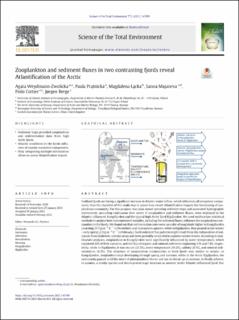| dc.description.abstract | Svalbard fjords are facing a significant increase in Atlantic water inflow, which influences all ecosystem components, thus the objective of this study was to assess how recent Atlantification impacts the functioning of zooplankton community. For this purpose, two year-round operating sediment traps and associated hydrographic instruments, providing continuous time series of zooplankton and sediment fluxes, were deployed in the Atlantic-influenced Kongsfjorden and the typical high Arctic fjord Rijpfjorden. We used multivariate statistical methods to analyze how environmental variables, including the sediment fluxes, influence the zooplankton communities in the fjords. We found out that sedimentation rates were an order of magnitude higher in Kongsfjorden (reaching 39.7 g m−2 d−1 in December) and increased in autumn, while in Rijpfjorden, they peaked in late winter - early spring (2.9 g m−2 d−1 in February). Such sediment flux patterns might result from the redeposition of sediments from shallower, subtidal areas and were probably connected to autumn/winter storms. According to multivariate analyses, zooplankton in Kongsfjorden were significantly influenced by water temperature, which explained 22% of their variation, and the flux of organic and mineral sediments explaining 15% and 7.8%, respectively; while in Rijpfjorden, it was sea ice (25.3%), water temperature (16.2%), salinity (8.1%), and mineral sedimentation (6.3%). The structure of zooplankton communities in both fjords was similar in winter; in Kongsfjorden, zooplankton kept developing through spring and summer, while in the Arctic Rijpfjorden, the community paused until the onset of phytoplankton bloom and sea ice break-up in summer, to finally achieve, in autumn, a similar species and development stage structure as summer in the Atlantic-influenced fjord. Our study demonstrates how integrating multiple pieces of information can provide key insights into the relations between Atlantification, sediment flux, and zooplankton community, thus helping to assess the functioning of high Arctic ecosystems under climate change conditions. | en_US |

